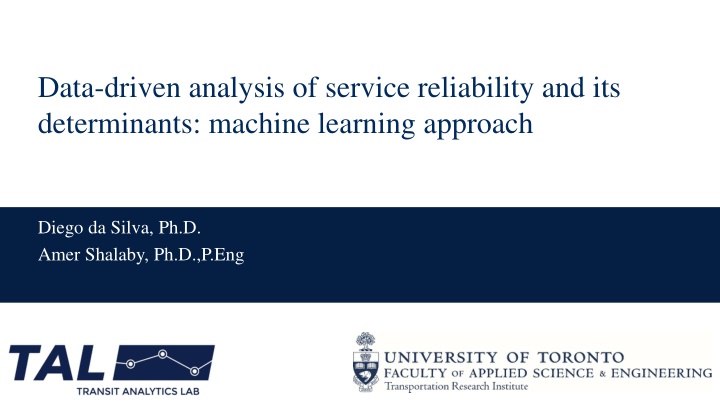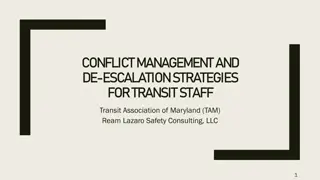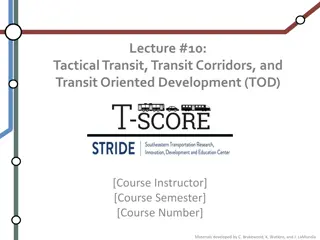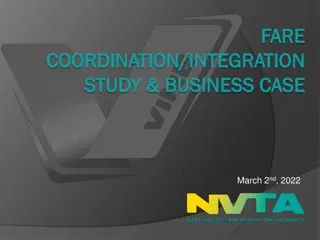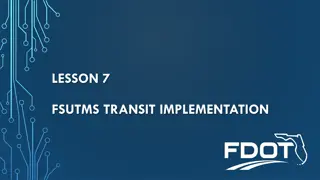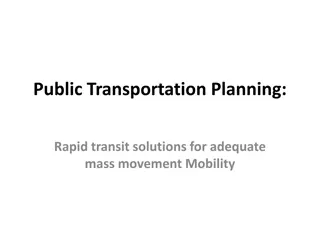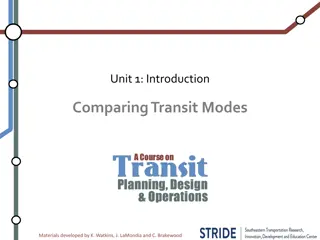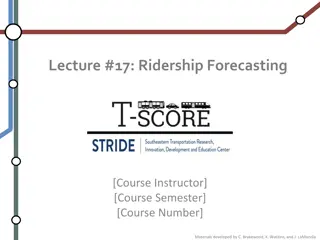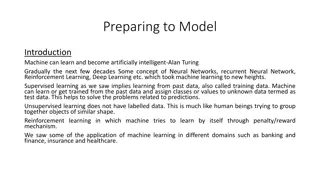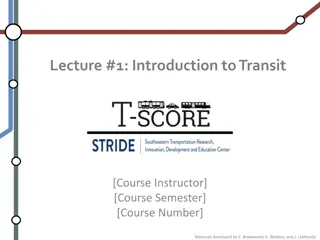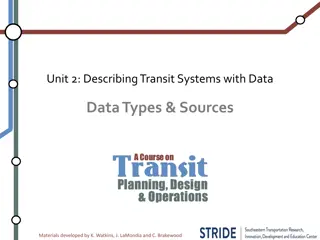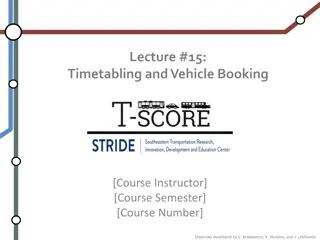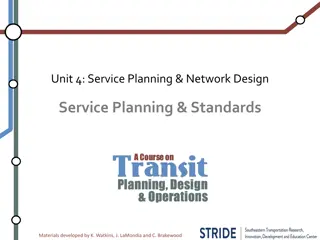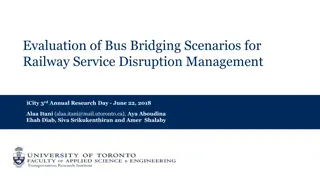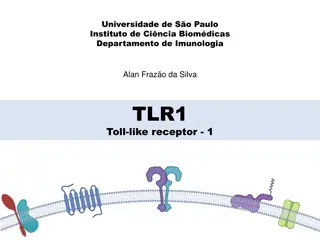Machine Learning Approach for Analyzing Service Reliability Factors in São Paulo Transit Data
Explore how machine learning methods are applied to analyze São Paulo transit data, focusing on factors affecting bus service reliability measures. The study delves into quantifying and identifying relevant factors impacting service reliability across different levels such as stops, routes, and the system as a whole. By utilizing ensemble methods and explainable artificial intelligence, the research aims to provide insights into service reliability categories and understand the main differences among factors per service frequency.
Download Presentation

Please find below an Image/Link to download the presentation.
The content on the website is provided AS IS for your information and personal use only. It may not be sold, licensed, or shared on other websites without obtaining consent from the author.If you encounter any issues during the download, it is possible that the publisher has removed the file from their server.
You are allowed to download the files provided on this website for personal or commercial use, subject to the condition that they are used lawfully. All files are the property of their respective owners.
The content on the website is provided AS IS for your information and personal use only. It may not be sold, licensed, or shared on other websites without obtaining consent from the author.
E N D
Presentation Transcript
Data-driven analysis of service reliability and its determinants: machine learning approach Diego da Silva, Ph.D. Amer Shalaby, Ph.D.,P.Eng
Focus and objective To explore S o Paulo transit data through ensemble methods and explainable artificial intelligence to quantify and identify factors impacting bus service reliability measures. How can factors affecting service reliability be quantified? What are the most relevant factors? How does one obtain insight through service reliability categories? How does one understand the main difference among factors per service frequency? Is it possible to build a framework to address multiple levels analysis (stop, route, system)? Data-driven analysis of service reliability and its determinants: machine learning approach 2
So Paulo - Brazil Evening Peak Morning Peak Midday Peak Palma ratio Region of Origin SP 9 9.8 BH 7 2.5 RJ Region of Destination 11,3 million people 1,521 km2 1,317 bus routes 14,000 vehicles 6 million pax/day 4,550 km road grid Most unlinked trips per passenger are concentrated at Region 9 (Central). S o Paulo is the most unequal city in Brazil when analyzing access within minutes of walking. [1] job 30 Region 9 is an essential hub of services, job opportunities, transit transfer and connection to other regions. [1] Pereira, R. H. M., Braga, C. K. V., Serra, B., and Nadalin, V. (2019). Desigualdades socioespaciais de acesso a oportunidades nas cidades brasileiras, 2019. Texto para Discuss o IPEA, 2535. Data-driven analysis of service reliability and its determinants: machine learning approach 3
Method The original dataset was collected from Jan to Sep 2017 for 1,317 routes, 14,000 bus vehicles every 20 seconds, which comprised more than 50 millions trips. Although machine learning methods are concerned about prediction, we use it as a quality validation for each model design and feature selection. Graph Network SHAP values explanation GTFS Tree-based model and SHAP values Headway and Travel Time Distribution Wait and travel time measures - Compute reliability measures: Expected wait time (E[W]), Excess wait time (EWT), 95th percentile (W95%), Potential wait time (Wpotential), RBT, TT95% - GTFS conversion to Graph Network [3] - Travel time interpolation for each node - Link distance - TreeSHAP distribution to obtain mean for each feature - Feature, aggregation - Multi-level explanation: stop, route and system - Spatial and frequency segmentation - CatBoost regression model, RMSE and MAPE scores - TreeSHAP values per feature and per row - Headway computation for the entire graph - Data engineering - Spatial and temporal aggregation (daily) - Data enrichment - EDA [3] Morais, M. A. and R. D. Camargo. A Framework for Scalable Data Analysis and Model Aggregation for Public Bus Systems. (2019). 4 Data-driven analysis of service reliability and its determinants: machine learning approach
Feature engineering and data enrichment Several data sources were used to derive the set of features describing the public transit service. The significant research effort was on data engineering/ feature selection, which provided numerous novelty techniques to work with large transit data. Source Data description MongoDB AVL data from Jan to Sep 2017 of all buses and routes every 20 seconds. GTFS-static Transit Agency wesite Google Elevation API Elevation data per route segment National Institute of Meteorology (INMET) Weather data from Jan to Sep 2017 S o Paulo City Open Data Transit Agency operation and demand data per route S o Paulo Traffic Enginering (CET) website Congestion Index from Jan to Sep 2017 5 Data-driven analysis of service reliability and its determinants: machine learning approach
Data sampling By 2017, S o Paulo had 1,317 routes, and our route selection was carefully done by using several data engineering techniques to encompass the main transit service, route description, and demand characteristics. The sample comprised 216 bus routes and approximately 5 million trips. Sample per service frequency Mean Pax/day per bus route Frequency threshold: High-frequency (HF) 14 min 14 min < Medium-frequency (MF) 27 min Low-frequency (LF) > 27 min Transit System Sample Bus routes Sample Data-driven analysis of service reliability and its determinants: machine learning approach 6
Key findings and aplicability The reliability measures that capture wait and travel time variability had a lower performance when compared with measures that included mean, median, percentile terms on their equations (E[W], W95%, TT95%). Moreover, the prediction error showed that it varied across spatial aggregation and service frequency. MAPE*Overall MAPE High-frequency MAPE Low-frequency *MAPE = Mean absolute percentage error Data-driven analysis of service reliability and its determinants: machine learning approach 7
Key findings and aplicability Once we calculated the TreeSHAP for each feature and prediction row in our cross-validation dataset, it was possible to observe the TreeSHAP distribution. For each spatial aggregation and service frequency we calculated the mean and computed the relative (%) effect on wait and travel time prediction and grouped features into six categories. Overall result (%) by category Service Frequency result (%) by category Acronyms: AG=Agency Service TO=Topology DE=Demand WE=Weather TR=Traffic WD=Weekday [4] Lundberg, S. M., Erion, G. G., Chen, H., DeGrave, A., Prutkin, J. M., Nair, B.,Katz, R., Himmelfarb, J., Bansal, N., and Lee, S. (2019). Explainable AI for trees:From local explanations to global understanding.CoRR, abs/1905.04610. Data-driven analysis of service reliability and its determinants: machine learning approach 8
Lessons learned and future directions Previous studies on service reliability relied on small datasets, representative samples, and models with low performance and poor generalization. New perspective and insights to deal with service reliability and transit data at scale. In S o Paulo, the whole system is frequency-based and the framework could distinguish high-frequency and low-frequency patterns. Although the expected impact of Agency Service category on service reliability, we could also observe that exogenous categories had at least 40% influence on the wait and travel time variability. Transit agencies can add more features and apply the framework to evaluate different service reliability measures performance. Agencies can also use the patterns identified on spatial aggregation and frequency segmentation for quality service decision- making. The next feasible step is city comparison and aggregate new features to evaluate model stability. Data-driven analysis of service reliability and its determinants: machine learning approach 9
Partners: Brazilian Council for Scientific and Technological Development Questions Questions Data-driven analysis of service reliability and its determinants: machine learning approach 10
